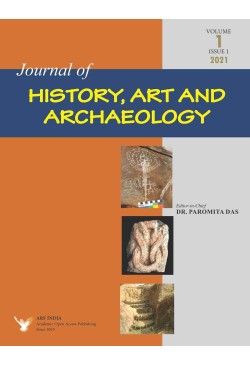
Journal of History, Art and Archaeology
Frequency :Bi-Annual
ISSN :2582-9637
Peer Reviewed Journal
ICONOGRAPHY OF PILGRIMAGE SITES: READINGS THROUGH THE MURAL PAINTINGS OF NATTAM KOVILPATTI, TAMIL NADU
Kumari, M.K. (2023). Iconography of Pilgrimage Sites: Readings through the Mural Paintings of Nattam Kovilpatti, Tamil Nadu. Journal of History, Art and Archaeology, 3: 1, pp. 1-12. https://doi.org/10.47509/JHAA.2023.v03i01.01
IMAGES OF DURGA-MAHISAMARDINI IN NORTH BENGAL: A HISTORICAL AND ICONOGRAPHICAL STUDY
Saktism is quite popular in the region of Bengal in eastern India where the Devi is worshipped in her different manifestations and known by different names. In this context, mention may be made about one of the major and popular manifestations of the Devi known as Durga-Mahisamardini, particularly in North Bengal. Various black basalt and sand stone images of Mahisamardini have been recovered from different parts of undivided Bengal and are now preserved in different museums of North Bengal. The present study is an attempt to understand the historical and iconographical context of these Mahisamardini images. These icons have been classified according to various parameters, such as find spot, time period, material used, and stylistic type so as to examine spatial and temporal similarities and variations.
???????Keywords: Sculpture, Samap?dasth?naka , Tribhanga, stelae, Lalit?sana, icon, Padma Khadga, Tri??la, Mukuta.
Sarkar, B., & Biswas, T. (2023). Images of Durga-Mahisamardini in North Bengal: A Historical and Iconographical Study. Journal of History, Art and Archaeology, 3: 1, pp. 13-22. https://doi.org/10.47509/JHAA.2023.v03i01.02
DURG? IN THE ROYAL EPIGRAPHS OF EARLY MEDIEVAL BENGAL
Debnath, G. (2023). Durg? in the Royal Epigraphs of Early Medieval Bengal. Journal of History, Art and Archaeology, 3: 1, pp. 23-26. https://doi.org/10.47509/JHAA.2023.v03i01.03
THE DISPOSAL METHOD OF THE DEAD IN TUENSANG VILLAGE, NAGALAND
Ngullie, R.C. (2023). The Disposal Method of the Dead in Tuensang Village, Nagaland. Journal of History, Art and Archaeology, 3: 1, pp. 27-31. https://doi.org/10.47509/JHAA.2023.v03i01.04
VEDIC WISDOM OF ?TA, THE COSMIC LAW: ITS SIGNIFICANCE IN HUMAN LIFE
Boddupalli, A., & Boddupalli, R.S. (2023). Vedic Wisdom of R.TA, The Cosmic Law: Its Significance in Human Life. Journal of History, Art and Archaeology, 3: 1, pp. 33-39. https://doi.org/10.47509/JHAA.2023.v03i01.05
RAAVAN TOL – NEW FINDINGS OF THE ROCK-CUT NATARAJA OF UDAYPUR, MADHYA PRADESH
Upadhyay, M.M. & Dixit, S. (2023). Raavan Tol – New Findings of the Rock-Cut Nataraja of Udaypur, Madhya Pradesh. Journal of History, Art and Archaeology, 3: 1, pp. 41-46. https://doi.org/10.47509/JHAA.2023.v03i01.06
LOCATING MUGHAL STATE FORMATION IN THE HIMALAYAN REGION: TWO REGIONAL CASE STUDIES
Chettry, A.T. (2023). Locating Mughal State Formation in the Himalayan Region: Two Regional Case Studies. Journal of History, Art and Archaeology, 3: 1, pp. 47-57. https://doi.org/10.47509/JHAA.2023.v03i01.07
ARCHITECTURAL FEATURES OF THE BRAHMANICAL TEMPLES OF ODISHA
Behera, R.P. (2023). Architectural Features of the Brahmanical Temples of Odisha. Journal of History, Art and Archaeology, 3: 1, pp. 59-67. https://doi.org/10.47509/JHAA.2023.v03i01.08
PROTOTYPE OF GRID IN URBAN HISTORY OF SINDH, PAKISTAN
Shaikh, J. (2023). Prototype of Grid in Urban History of Sindh, Pakistan. Journal of History, Art and Archaeology, 3: 1, pp. 69-84. https://doi.org/10.47509/JHAA.2023.v03i01.09
FROM ROCK ART TO STREET ART- CAVES TO WALLS: AN INSIGHT INTO THE ARTISTIC DEVELOPMENT OF PAINTED WALL ART FROM PREHISTORIC TO MODERN-DAY IN INDIA
Sandhu, S. (2023). From Rock Art to Street Art-Caves to Walls: An Insight into the Artistic Development of Painted Wall Art from Prehistoric to Modern-Day in India. Journal of History, Art and Archaeology, 3: 1, pp. 85-96. https://doi.org/10.47509/JHAA.2023.v03i01.10
THE PEMAYANGTSE AND TAWANG MONASTERIES IN PRE-COLONIAL INDIA: A COMPARATIVE STUDY
The monastery of Pemayangtse and the monastery of Tawang are two prominent Buddhist monasteries situated in the Eastern Himalayan region of India. The Pemayangtse monastery, located in the state of Sikkim belongs to the Nyingma tradition and was established by Master Lhastsun Namkha Jigme in 1642 CE. It was later re-established in 1705 CE during the reign of Chakdor Namgyal, the third king of Sikkim. From the time of its foundation, it remained under the control of the kings of Sikkim, being guided by their policies of the elite class. The Tawang Monastery of Arunachal Pradesh is influenced by the Gelugpa sect and was founded by Marak Lama Lodre Gyatso around 1680–1681 CE. In contrast to Pemayangtse, the Tawang Monastery has been thriving and is being nourished by the services and deeds of the common people belonging to the tribes such as Monpa and the Sherdukpen. While both are Buddhist institutions, they appear to differ in their role and functions. In this paper, an attempt has been made to identify the major similarities and differences between these monasteries which are influenced by different Buddhist traditions of Tibet by analysing their politico-social conditions. The paper is based upon field study supplemented by secondary sources.
Keywords: Tawang, Pemayangtse, Tribe, Lhopo, Monpa, Sherdukpen, Gelugpa, Nyingma